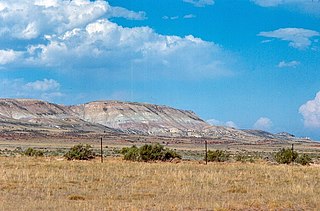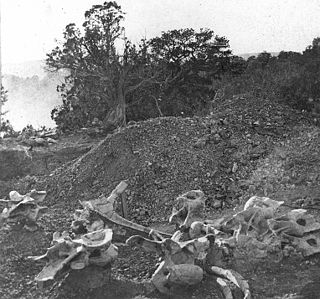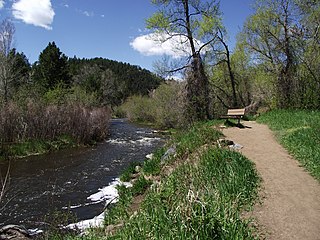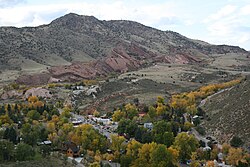
Apatosaurus is a genus of herbivorous sauropod dinosaur that lived in North America during the Late Jurassic period. Othniel Charles Marsh described and named the first-known species, A. ajax, in 1877, and a second species, A. louisae, was discovered and named by William H. Holland in 1916. Apatosaurus lived about 152 to 151 million years ago (mya), during the late Kimmeridgian to early Tithonian age, and are now known from fossils in the Morrison Formation of modern-day Colorado, Oklahoma, New Mexico, Wyoming, and Utah in the United States. Apatosaurus had an average length of 21–23 m (69–75 ft), and an average mass of 16.4–22.4 t. A few specimens indicate a maximum length of 11–30% greater than average and a mass of approximately 33 t.

West Pleasant View is an unincorporated community and a census-designated place (CDP) located in and governed by Jefferson County, Colorado, United States. The CDP is a part of the Denver–Aurora–Lakewood, CO Metropolitan Statistical Area. The population of the West Pleasant View CDP was 4,327 at the United States Census 2020. The Pleasant View Metropolitan District provides services. The Golden post office serves the area.

Stegosaurus is a genus of herbivorous, four-legged, armored dinosaur from the Late Jurassic, characterized by the distinctive kite-shaped upright plates along their backs and spikes on their tails. Fossils of the genus have been found in the western United States and in Portugal, where they are found in Kimmeridgian- to Tithonian-aged strata, dating to between 155 and 145 million years ago. Of the species that have been classified in the upper Morrison Formation of the western US, only three are universally recognized: S. stenops, S. ungulatus and S. sulcatus. The remains of over 80 individual animals of this genus have been found. Stegosaurus would have lived alongside dinosaurs such as Apatosaurus, Diplodocus, Camarasaurus and Allosaurus, the latter of which may have preyed on it.

Dinosaur National Monument is an American national monument located on the southeast flank of the Uinta Mountains on the border between Colorado and Utah at the confluence of the Green and Yampa rivers. Although most of the monument area is in Moffat County, Colorado, the Dinosaur Quarry is located in Utah, north of the town of Jensen, Utah. The nearest Colorado town is Dinosaur while the nearest city is Vernal, Utah.

The Morrison Formation is a distinctive sequence of Upper Jurassic sedimentary rock found in the western United States which has been the most fertile source of dinosaur fossils in North America. It is composed of mudstone, sandstone, siltstone, and limestone and is light gray, greenish gray, or red. Most of the fossils occur in the green siltstone beds and lower sandstones, relics of the rivers and floodplains of the Jurassic period.

Como Bluff is a long ridge extending east–west, located between the towns of Rock River and Medicine Bow, Wyoming. The ridge is an anticline, formed as a result of compressional geological folding. Three geological formations, the Sundance, the Morrison, and the Cloverly Formations, containing fossil remains from the Late Jurassic of the Mesozoic Era are exposed.

Marshosaurus is a genus of medium-sized carnivorous theropod dinosaur, belonging to the family Piatnitzkysauridae, from the Late Jurassic Morrison Formation of Utah and possibly Colorado.
Arthur Lakes was an American geologist, artist, writer, teacher and Episcopalian minister. He captured much of his geological and palaeontological field work in sketches and watercolours. Lakes is credited with successfully deciphering much of the geology of Colorado and, as an economic geologist, guiding mineral exploration which was so important to the State.

The Dry Mesa Dinosaur Quarry is situated in southwestern Colorado, United States, near the town of Delta. Its geology forms a part of the Morrison Formation and has famously yielded a great diversity of animal remains from the Jurassic Period, among them Ceratosaurus, Supersaurus, and Torvosaurus. The quarry is found within the Uncompahgre National Forest.

Garden Park is a paleontological site in Fremont County, Colorado, known for its Jurassic dinosaurs and the role the specimens played in the infamous Bone Wars of the late 19th century. Located 10 km (6.2 mi) north of Cañon City, the name originates from the area providing vegetables to the miners at nearby Cripple Creek in the 19th century. Garden Park proper is a triangular valley surrounded by cliffs on the southeast and southwest and by mountains to the north; however, the name is also refers to the dinosaur sites on top and along the cliffs. The dinosaur sites now form the Garden Park Paleontological Resource Area, which is overseen by the Bureau of Land Management.

The Lariat Loop National Scenic and Historic Byway is a National Scenic Byway and a Colorado Scenic and Historic Byway located in Jefferson County, Colorado, USA. The byway is a 40-mile (64 km) loop in the Front Range foothills west of Denver through Golden, Lookout Mountain Park, Genesee Park, Evergreen, Morrison, Red Rocks Park, and Dinosaur Ridge. The Lariat Loop connects to the Mount Evans Scenic Byway at Bergen Park.

This is an alphabetical list of articles related to the U.S. State of Colorado.

Dinosaur Ridge is a segment of the Dakota Hogback in the Morrison Fossil Area National Natural Landmark located in Jefferson County, Colorado, near the town of Morrison and just west of Denver.

The LoDaisKa site is a prominent archaeological site in the U.S. state of Colorado, located within a rockshelter near Morrison. The rockshelter was first inhabited by people of the Archaic through the Middle Ceramic period, generally spanning 3000 BC to 1000 AD.

Paleontology in Colorado refers to paleontological research occurring within or conducted by people from the U.S. state of Colorado. The geologic column of Colorado spans about one third of Earth's history. Fossils can be found almost everywhere in the state but are not evenly distributed among all the ages of the state's rocks. During the early Paleozoic, Colorado was covered by a warm shallow sea that would come to be home to creatures like brachiopods, conodonts, ostracoderms, sharks and trilobites. This sea withdrew from the state between the Silurian and early Devonian leaving a gap in the local rock record. It returned during the Carboniferous. Areas of the state not submerged were richly vegetated and inhabited by amphibians that left behind footprints that would later fossilize. During the Permian, the sea withdrew and alluvial fans and sand dunes spread across the state. Many trace fossils are known from these deposits.

Paleontology in Utah refers to paleontological research occurring within or conducted by people from the U.S. state of Utah. Utah has a rich fossil record spanning almost all of the geologic column. During the Precambrian, the area of northeastern Utah now occupied by the Uinta Mountains was a shallow sea which was home to simple microorganisms. During the early Paleozoic Utah was still largely covered in seawater. The state's Paleozoic seas would come to be home to creatures like brachiopods, fishes, and trilobites. During the Permian the state came to resemble the Sahara desert and was home to amphibians, early relatives of mammals, and reptiles. During the Triassic about half of the state was covered by a sea home to creatures like the cephalopod Meekoceras, while dinosaurs whose footprints would later fossilize roamed the forests on land. Sand dunes returned during the Early Jurassic. During the Cretaceous the state was covered by the sea for the last time. The sea gave way to a complex of lakes during the Cenozoic era. Later, these lakes dissipated and the state was home to short-faced bears, bison, musk oxen, saber teeth, and giant ground sloths. Local Native Americans devised myths to explain fossils. Formally trained scientists have been aware of local fossils since at least the late 19th century. Major local finds include the bonebeds of Dinosaur National Monument. The Jurassic dinosaur Allosaurus fragilis is the Utah state fossil.

Paleontology in the United States refers to paleontological research occurring within or conducted by people from the United States. Paleontologists have found that at the start of the Paleozoic era, what is now "North" America was actually in the southern hemisphere. Marine life flourished in the country's many seas. Later the seas were largely replaced by swamps, home to amphibians and early reptiles. When the continents had assembled into Pangaea drier conditions prevailed. The evolutionary precursors to mammals dominated the country until a mass extinction event ended their reign.

The history of paleontology in the United States refers to the developments and discoveries regarding fossils found within or by people from the United States of America. Local paleontology began informally with Native Americans, who have been familiar with fossils for thousands of years. They both told myths about them and applied them to practical purposes. African slaves also contributed their knowledge; the first reasonably accurate recorded identification of vertebrate fossils in the new world was made by slaves on a South Carolina plantation who recognized the elephant affinities of mammoth molars uncovered there in 1725. The first major fossil discovery to attract the attention of formally trained scientists were the Ice Age fossils of Kentucky's Big Bone Lick. These fossils were studied by eminent intellectuals like France's George Cuvier and local statesmen and frontiersman like Daniel Boone, Benjamin Franklin, William Henry Harrison, Thomas Jefferson, and George Washington. By the end of the 18th century possible dinosaur fossils had already been found.

Bear Creek is a tributary of the South Platte River in central Colorado in the United States. It begins as a small creek up in the Mount Blue Sky Wilderness in Summit Lake and makes its way through Evergreen, CO, Kittredge, CO, Idledale, CO and Morrison, CO before entering Bear Creek Lake Park, managed by the City of Lakewood, Colorado.




















